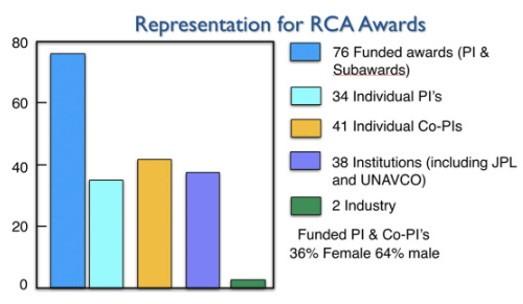
1 minute read
RCA External Funding Since 2016
The National Science Foundation, in 2016, began to allow external users to submit proposals to add infrastructure onto the OOI arrays, as well as data research, and education-focused efforts. Since that time, 76 awards have been made to Principal Investigators (PI’s) (N=44) and CoPI’s (N=32) centered on the Regional Cabled Array, including numerous field programs. Regional Cabled Array externally funded programs are from a diverse portfolio that includes the NSF, the Office of Navy Research, the National Aeronautics and Space Administration, the Bureau of Ocean Energy Management, and a several year international award from Germany through the Federal Ministry of Education and Research. The recipient scientists, engineers, and educators include 34 individual PI’s and 41 Co-Pi’s from 38 institutions, including the Jet Propulsion Lab and the University NAVSTAR Consortium (UNAVCO). NSF awards have been through OCE Geology, Biology, Chemistry, and Education and Ocean Technology and Interdisciplinary 23 Coordination, as well as Earth Cube and include EAGER,
Two recent NSF awards are the first of their kind: 1) The first community Distributed Acoustic Sensing (DAS) ocean experiment using this emergent transformational technology (OCE 214107) “RAPID: A Community Test of Distributed Acoustic Sensing on the Ocean Observatories Initiative Regional Cabled Array;” and 2) the first cabled and uncabled acoustic array on an active volcano (Axial Seamount) (OCE 2130060) “An Acoustic Array at Axial Seamount for Geodesy and Autonomous Vehicle Support”. This array includes a four-station acoustic network with temperature, pressure, and velocimeter instruments to be installed this summer inside the caldera and on top of the caldera walls, as well as a smart cable connected to a RCA junction box hosting an internal pressure sensor for transmission of data live to shore. The horizontal strain measurements enabled by the acoustic network will aide in determining the relative roles of magma chamber inflation and deflation and motion on buried faults beneath the caldera walls. This network forms the foundation to demonstrate and optimize remote communication and navigation of AUVs, an essential step toward the deployment of remotely operated AUVs that can capture future eruptions.
Advertisement











